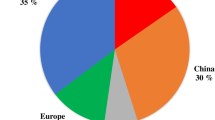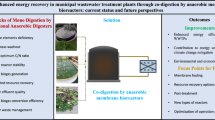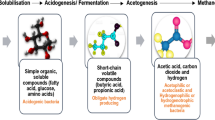Abstract
CO2 capture from biogas is an effective route to facilitate the utilization of biogas by improving its CH4 purity. In this work, choline chloride-monoethanolamine deep eutectic solvent (ChCl-MEA DES), was employed as a promising absorbent for CO2 capture. The effects of absorption pressure and temperature, and water content in DES, on CO2 absorption capacity, rates, and selectivity were experimentally evaluated. The experimental data were analyzed by analysis of variance (ANOVA) and response surface method (RSM). The absorption behavior of CO2 by DES mainly conformed to the laws of physical absorption. The highest CO2 absorption capacity of ChCl-MEA DES was 0.608 mol-CO2/mol-DES, and the best CO2/CH4 selectivity factor was 25. Regression equations of CO2 absorption capacity and rate were established to evaluate the results under different operating conditions.










Similar content being viewed by others
Data availability
The data that support the findings of this study are available from the corresponding author, HW, upon reasonable request.
References
He S, Li M, Fu T, Bao W (2020) An overview of current situation and prospects on livestock excrement management policies in China. J China Agric. Univ. 25:22–37
Wang Y, Zhang Y, Li J, Lin J-G, Zhang N, Cao W (2021) Biogas energy generated from livestock manure in China: current situation and future trends. J Environ Manage 297:113324. https://doi.org/10.1016/j.jenvman.2021.113324
Ling Y, Ma J, Qin F (2012) The structure distribution and prospect of China manure resource, Chinese Agricultural. Science Bulletin 28:1–5
Bao W, Yang Y, Fu T, Xie GH (2019) Estimation of livestock excrement and its biogas production potential in China. J Clean Prod 229:1158–1166. https://doi.org/10.1016/j.jclepro.2019.05.059
Giwa AS, Ali N, Ahmad I, Asif M, Guo R-B, Li F-L, Lu M (2020) Prospects of China’s biogas: fundamentals, challenges and considerations. Energy Rep 6:2973–2987. https://doi.org/10.1016/j.egyr.2020.10.027
Wellinger A, Murphy J, Baxter D (2013) The biogas handbook: science, production and applications, The biogas handbook : science, production and applications. WoodheadPublishing
Abdeshahian P, Lim JS, Ho WS, Hashim H, Lee CT (2016) Potential of biogas production from farm animal waste in Malaysia. Renew Sustain Energy Rev 60:714–723. https://doi.org/10.1016/j.rser.2016.01.117
Yentekakis IV, Grammatiki G(2017) Biogas Management: advanced utilization for production of renewable energy and added-value chemicals, Frontiers in Environmental Science 5:7. https://doi.org/10.3389/fenvs.2017.00007
Sun Q, Li H, Yan J, Liu L, Yu Z, Yu X (2015) Selection of appropriate biogas upgrading technology-a review of biogas cleaning, upgrading and utilisation. Renew Sustain Energy Rev 51:521–532. https://doi.org/10.1016/j.rser.2015.06.029
Ahmed SF, Mofijur M, Tarannum K, Chowdhury AT, Rafa N, Nuzhat S, Kumar, PS Vo D, Lichtfouse E, Mahlia T (2021) Biogas upgrading, economy and utilization: a review. Environmental Chemistry Letters 1–28. https://doi.org/10.1007/s10311-021-01292-x
Hosseini SE, Wahid MA (2014) Development of biogas combustion in combined heat and power generation. Renew Sustain Energy Rev 40:868–875. https://doi.org/10.1016/j.rser.2014.07.204
Yu CH, Huang CH, Tan CS (2012) A review of CO2 capture by absorption and adsorption. Aerosol and Air Quality Research 12:745–769. https://doi.org/10.4209/aaqr.2012.05.0132
Luis P (2016) Use of monoethanolamine (MEA) for CO2 capture in a global scenario: consequences and alternatives. Desalination 380:93–99. https://doi.org/10.1016/j.desal.2015.08.004
Kamgar A, Mohsenpour S, Esmaeilzadeh F (2017) Solubility prediction of CO2, CH4, H2, CO and N2 in choline chloride/urea as a eutectic solvent using NRTL and COSMO-RS models. J Mol Liq 247:70–74. https://doi.org/10.1016/j.molliq.2017.09.101
Ali E, Hadj-Kali MK, Mulyono S, Alnashef I, Fak Ee Ha A, Mjalli F, Hayyan A (2014) Solubility of CO in deep eutectic solvents: experiments and modelling using the Peng–Robinson equation of state, Chemical Engineering Research & Design 92:1898–1906. https://doi.org/10.1016/j.cherd.2014.02.004
Leron RB, Li M-H (2013) Solubility of carbon dioxide in a eutectic mixture of choline chloride and glycerol at moderate pressures. J Chem Thermodyn 57:131–136. https://doi.org/10.1016/j.jct.2012.08.025
Haider MB, Jha D, Marriyappan Sivagnanam B, Kumar R (2018) Thermodynamic and kinetic studies of CO capture by glycol and amine-based deep eutectic solvents, Journal of Chemical & Engineering Data 63:2671–2680. https://doi.org/10.1021/acs.jced.8b00015
Cui P, Liu X, Zhao F, Zhu Z, Wang L, Wang Y (2020) Molecular mechanism, thermoeconomic, and environmental impact for separation of isopropanol and water using the choline-based DESs as extractants. Ind Eng Chem Res 59:16077–16087. https://doi.org/10.1021/acs.iecr.0c02794
Zhang Y, Ji X, Lu X (2018) Choline-based deep eutectic solvents for CO2 separation: review and thermodynamic analysis. Renew Sustain Energy Rev 97:436–455. https://doi.org/10.1016/j.rser.2018.08.007
Adeyemi I, Abu-Zahra MRM, Alnashef I (2017) Experimental study of the solubility of CO2 in novel amine based deep eutectic solvents. Energy Procedia 105:1394–1400. https://doi.org/10.1016/j.egypro.2017.03.519
Li M, Guan J, Han J, Liang W, Wang K, Duan E, Guo B (2015) Absorption and oxidation of H2S in triethylamine hydrochloride·ferric chloride ionic liquids. J Mol Liq 209:58–61. https://doi.org/10.1016/j.molliq.2015.05.002
Liu F, Chen W, Mi J et al (2019) Thermodynamic and molecular insights into the absorption of H2S, CO2, and CH4 in choline chloride plus urea mixtures. AIChE J 65:e16574 https://doi.org/10.1002/aic.16574
Wibowo H, Susanto H, Grisdanurak N, Hantoko D, Yoshikawa K, Qun H, Yan M (2021) Recent developments of deep eutectic solvent as absorbent for CO2 removal from syngas produced from gasification: current status, challenges, and further research. J Environ Chem Eng 9:105439. https://doi.org/10.1016/j.jece.2021.105439
Florindo C, Lima F, Ribeiro BD, Marrucho IM (2019) Deep eutectic solvents: overcoming 21st century challenges, Current Opinion in Green and Sustainable. Chemistry 18:31–36. https://doi.org/10.1016/j.cogsc.2018.12.003
García G, Atilhan M, Aparicio S (2015) A theoretical study on mitigation of CO2 through advanced deep eutectic solvents. Int J Greenhouse Gas Control 39:62–73. https://doi.org/10.1016/j.ijggc.2015.05.004
Bi Y, Hu Z, Lin X, Ahmad N, Xu J, Xu X (2020) Efficient CO2 capture by a novel deep eutectic solvent through facile, one-pot synthesis with low energy consumption and feasible regeneration. Sci Total Environ 705:135798. https://doi.org/10.1016/j.scitotenv.2019.135798
Gabriele F, Chiarini M, Germani R, Tiecco M, Spreti N (2019) Effect of water addition on choline chloride/glycol deep eutectic solvents: characterization of their structural and physicochemical properties, Journal of Molecular Liquids 291:111301. https://doi.org/10.1016/j.molliq.2019.111301
H. Wibowo, L. Zhong, Q. Huan, Q. Hu, D.A. Rahim, M. Yan, Experimental study on the effect of water addition to ChCl-MEA DES towards its performance in CO2 removal from syngas, Biomass Conversion and Biorefinery, (2021). https://doi.org/10.1007/s13399-021-01673-w
Mjalli FS, Murshid G, Al-Zakwani S, Hayyan A (2017) Monoethanolamine-based deep eutectic solvents, their synthesis and characterization. Fluid Phase Equilib 448:30–40. https://doi.org/10.1016/j.fluid.2017.03.008
Li Z, Wang L, Li C, Cui Y, Li S, Yang G, Shen Y (2019) Absorption of carbon dioxide using ethanolamine-based deep eutectic solvents. ACS Sustainable Chemistry & Engineering 7:10403–10414. https://doi.org/10.1021/acssuschemeng.9b00555
Ghaedi H, Ayoub M, Sufian S, Lal B, Shariff AM (2017) Measurement and correlation of physicochemical properties of phosphonium-based deep eutectic solvents at several temperatures (293.15K–343.15K) for CO capture. The Journal of Chemical Thermodynamics 113:41–51. https://doi.org/10.1016/j.jct.2017.05.020
Mandal BP, Biswas AK, Bandyopadhyay SS (2004) Selective absorption of H2S from gas streams containing H2S and CO2 into aqueous solutions of N-methyldiethanolamine and 2-amino-2-methyl-1-propanol. Sep Purif Technol 35:191–202. https://doi.org/10.1016/S1383-5866(03)00139-4
Shashi K, Shukla J-P (2019) Mikkola, Unusual temperature-promoted carbon dioxide capture in deep-eutectic solvents: the synergistic interactions. Chem Commun (Camb) 55:3939–3942. https://doi.org/10.1039/C9CC00831D
Fisher RA (1992) Statistical Methods for Research Workers. In: Kotz S, Johnson NL (eds) Breakthroughs in Statistics. Springer Series in Statistics (Perspectives in Statistics). New York: Springer pp 66–70 https://doi.org/10.1007/BF01603396
Kim YE, Jin AL, Jeong SK, Yoon YI, Nam SC (2013) Comparison of carbon dioxide absorption in aqueous MEA, DEA, TEA, and AMP solutions. Bulletin of the Korean Chemical Society 34:783–787. https://doi.org/10.5012/bkcs.2013.34.3.783
Yang J, Wen J, Wu G, Liu Q, Kirk D, Bao S (2012) CO2 Absorption in Aqueous Monoethanolamine/Methyldiethanolamine/ Diethylenetriamine and Their Blends Solutions. Asian Journal of Chemistry 25(1):563–566
Shen Y, Hung FR (2017) A molecular simulation study of carbon dioxide uptake by a deep eutectic solvent confined in slit nanopores. The Journal of Physical Chemistry C 121:24562–24575. https://doi.org/10.1021/acs.jpcc.7b07315
Zhang Z, Liu X, Yao D, Ma Z, Zhao J, Zhang W, Cui P, Ma Y, Zhu Z, Wang Y (2021) Molecular kinetic extraction mechanism analysis of 1-butanol from n-heptane-1-butanol by choline-based DESs as extractants. J Mol Liq 322:114665. https://doi.org/10.1016/j.molliq.2020.114665
Ali E, Hadj-Kali MK, Mulyono S, Alnashef I, Fakeeha A, Mjalli F, Hayyan A (2014) Solubility of CO2 in deep eutectic solvents: experiments and modelling using the Peng-Robinson equation of state. Chem Eng Res Des 92:1898–1906. https://doi.org/10.1016/j.cherd.2014.02.004
Lloret JO, Vega LF, Llovell F (2017) Accurate description of thermophysical properties of tetraalkylammonium chloride deep eutectic solvents with the soft-SAFT equation of state. Fluid Phase Equilib 448:81–93. https://doi.org/10.1016/j.fluid.2017.04.013
Zubeir LF, Osch DV, Rocha M, Banat F, Kroon MC (2018) carbon dioxide solubilities in decanoic acid-based hydrophobic deep eutectic solvents. Journal of Chemical & Engineering Data 63:913–919. https://doi.org/10.1021/acs.jced.7b00534
Ren H, Lian S, Wang X, Zhang Y, Duan E (2018) Exploiting the hydrophilic role of natural deep eutectic solvents for greening CO2 capture. J Clean Prod 193:802–810. https://doi.org/10.1016/j.jclepro.2018.05.051
Kwan JS, Baek I, Lee S (2008) CO2 absorption in ionic liquids. Korean Chemical Engineering Research 46:492–497
Wang Y, Liu X, Kraslawski A, Gao J, Cui P (2019) A novel process design for CO2 capture and H2S removal from the syngas using ionic liquid. J Clean Prod 213:480–490. https://doi.org/10.1016/j.jclepro.2018.12.180
Ramdin M, Amplianitis A, Bazhenov S, Volkov A, Volkov V, Vlugt TJH, de Loos TW (2014) Solubility of CO2 and CH4 in ionic liquids: ideal CO2/CH4 Selectivity. Ind Eng Chem Res 53:15427–15435. https://doi.org/10.1021/ie4042017
Haider MB, Kumar R (2020) Solubility of CO2 and CH4 in sterically hindered amine-based deep eutectic solvents. Sep Purif Technol 248:117055. https://doi.org/10.1016/j.seppur.2020.117055
Acknowledgements
The authors appreciate the financial support from the International Cooperation Project of Zhejiang Province (2019C04026) and the National Natural Science Foundation (51,976,196).
Funding
This study was funded by the International Cooperation Project of Zhejiang Province (Grant No. 2019C04026) and the National Natural Science Foundation (Grant No. 51976196).
Author information
Authors and Affiliations
Contributions
Conceptualization: Qun Huan and Haryo Wibowo; methodology: Qun Huan, Wei Fang, and Feng Chen; formal analysis and investigation: Qun Huan and Yan Zhang; writing—original draft preparation: Qun Huan and Haryo Wibowo; writing—review and editing: Ekkachai Kanchanatip and Agamuthu Pariatamby; funding acquisition: Yan Mi; resources: Yan Mi and Ekkachai Kanchanatip; supervision: Yan Mi and Agamuthu Pariatamby.
Corresponding author
Ethics declarations
Competing interests
The authors declare no competing interests.
Additional information
Publisher's note
Springer Nature remains neutral with regard to jurisdictional claims in published maps and institutional affiliations.
Highlights
• The absorption behavior of CO2 from biogas by ChCl-MEA DES was studied.
• The highest absorption capacity of CO2 was 0.608 mol-CO2/mol-DES.
• The highest selectivity factor of CO2/CH4 was 25.
• ANOVA was employed to map the systematic absorption and establish the regression equation.
Rights and permissions
About this article
Cite this article
Yan, M., Huan, Q., Zhang, Y. et al. Effect of operating parameters on CO2 capture from biogas with choline chloride—monoethanolamine deep eutectic solvent and its aqueous solution. Biomass Conv. Bioref. 14, 283–297 (2024). https://doi.org/10.1007/s13399-021-02246-7
Received:
Revised:
Accepted:
Published:
Issue Date:
DOI: https://doi.org/10.1007/s13399-021-02246-7




